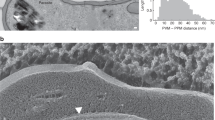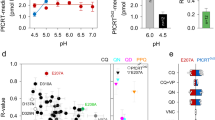Abstract
The plasmodial surface anion channel (PSAC) is a voltage-dependent ion channel on erythrocytes infected with malaria parasites. To fulfill its presumed function in parasite nutrient acquisition, PSAC is permeant to a broad range of charged and uncharged solutes; it nevertheless excludes Na+ as required to maintain erythrocyte osmotic stability in plasma. Another surprising property of PSAC is its small single-channel conductance (<3 pS in isotonic Cl−) in spite of broad permeability to bulky solutes. While exploring the mechanisms underlying these properties, we recently identified interactions between permeating solutes and PSAC inhibitors that suggest the channel has more than one route for passage of solutes. Here, we explored this possibility with 22 structurally diverse solutes and found that each could be classified into one of two categories based on effects on inhibitor affinity, the temperature dependence of these effects and a clear pattern of behavior in permeant solute mixtures. The clear separation of these solutes into two discrete categories suggests two distinct mechanisms of transport through this channel. In contrast to most other broad-permeability channels, selectivity in PSAC appears to be complex and cannot be adequately explained by simple models that invoke sieving through rigid, noninteracting pores.





Similar content being viewed by others
References
Alkhalil A, Cohn JV, Wagner MA, Cabrera JS, Rajapandi T, Desai SA (2004) Plasmodium falciparum likely encodes the principal anion channel on infected human erythrocytes. Blood 104:4279–4286
Brelidze TI, Niu X, Magleby KL (2003) A ring of eight conserved negatively charged amino acids doubles the conductance of BK channels and prevents inward rectification. Proc Natl Acad Sci USA 100:9017–9022
Cohn JV, Alkhalil A, Wagner MA, Rajapandi T, Desai SA (2003) Extracellular lysines on the plasmodial surface anion channel involved in Na+ exclusion. Mol Biochem Parasitol 132:27–34
Cruickshank CC, Minchin RF, Le Dain AC, Martinac B (1997) Estimation of the pore size of the large-conductance mechanosensitive ion channel of Escherichia coli. Biophys J 73:1925–1931
Desai SA, Bezrukov SM, Zimmerberg J (2000) A voltage-dependent channel involved in nutrient uptake by red blood cells infected with the malaria parasite. Nature 406:1001–1005
Desai SA, Alkhalil A, Kang M, Ashfaq U, Nguyen ML (2005) Plasmodial surface anion channel–independent phloridzin resistance in Plasmodium falciparum. J Biol Chem 280:16861–16867
Egee S, Lapaix F, Decherf G, Staines HM, Ellory JC, Doerig C, Thomas SL (2002) A stretch-activated anion channel is up-regulated by the malaria parasite Plasmodium falciparum. J Physiol 542:795–801
Ertl P, Rohde B, Selzer P (2000) Fast calculation of molecular polar surface area as a sum of fragment-based contributions and its application to the prediction of drug transport properties. J Med Chem 43:3714–3717
Ginsburg H, Kutner S, Krugliak M, Cabantchik ZI (1985) Characterization of permeation pathways appearing in the host membrane of Plasmodium falciparum infected red blood cells. Mol Biochem Parasitol 14:313–322
Hill DA, Pillai AD, Nawaz F, Hayton K, Doan L, Lisk G, Desai SA (2007) A blasticidin S–resistant Plasmodium falciparum mutant with a defective plasmodial surface anion channel. Proc Natl Acad Sci USA 104:1063–1068
Huber SM, Uhlemann AC, Gamper NL, Duranton C, Kremsner PG, Lang F (2002) Plasmodium falciparum activates endogenous Cl− channels of human erythrocytes by membrane oxidation. EMBO J 21:22–30
Kang M, Lisk G, Hollingworth S, Baylor SM, Desai SA (2005) Malaria parasites are rapidly killed by dantrolene derivatives specific for the plasmodial surface anion channel. Mol Pharmacol 68:34–40
Lisk G, Desai SA (2005) The plasmodial surface anion channel is functionally conserved in divergent malaria parasites. Eukaryot Cell 4:2153–2159
Lisk G, Kang M, Cohn JV, Desai SA (2006) Specific inhibition of the plasmodial surface anion channel by dantrolene. Eukaryot Cell 5:1882–1893
Lisk G, Scott S, Solomon T, Pillai AD, Desai SA (2007) Solute–inhibitor interactions in the plasmodial surface anion channel reveal complexities in the transport process. Mol Pharmacol 71:1241–1250
Lisk G, Pain M, Gluzman IY, Kambhampati S, Furuya T, Su XZ, Fay MP, Goldberg DE, Desai SA (2008) Changes in the plasmodial surface anion channel reduce leupeptin uptake and can confer drug resistance in P. falciparum–infected erythrocytes. Antimicrob Agents Chemother 52:2346–2354
Phale PS, Philippsen A, Widmer C, Phale VP, Rosenbusch JP, Schirmer T (2001) Role of charged residues at the OmpF porin channel constriction probed by mutagenesis and simulation. Biochemistry 40:6319–6325
Rostovtseva TK, Nestorovich EM, Bezrukov SM (2002) Partitioning of differently sized poly(ethylene glycol)s into OmpF porin. Biophys J 82:160–169
Salkoff L, Butler A, Ferreira G, Santi C, Wei A (2006) High-conductance potassium channels of the SLO family. Nat Rev Neurosci 7:921–931
Staines HM, Rae C, Kirk K (2000) Increased permeability of the malaria-infected erythrocyte to organic cations. Biochim Biophys Acta 1463:88–98
Staines HM, Powell T, Ellory JC, Egee S, Lapaix F, Decherf G, Thomas SL, Duranton C, Lang F, Huber SM (2003) Modulation of whole-cell currents in Plasmodium falciparum–infected human red blood cells by holding potential and serum. J Physiol 552:177–183
Staines HM, Alkhalil A, Allen RJ, De Jonge HR, Derbyshire E, Egee S, Ginsburg H, Hill DA, Huber SM, Kirk K, Lang F, Lisk G, Oteng E, Pillai AD, Rayavara K, Rouhani S, Saliba KJ, Shen C, Solomon T, Thomas SL, Verloo P, Desai SA (2007) Electrophysiological studies of malaria parasite–infected erythrocytes: current status. Int J Parasitol 37:475–482
Verloo P, Kocken CH, van der WA, Tilly BC, Hogema BM, Sinaasappel M, Thomas AW, De Jonge HR (2004) Plasmodium falciparum–activated chloride channels are defective in erythrocytes from cystic fibrosis patients. J Biol Chem 279:10316–10322
Wagner MA, Andemariam B, Desai SA (2003) A two-compartment model of osmotic lysis in Plasmodium falciparum–infected erythrocytes. Biophys J 84:116–123
Zhao YH, Abraham MH, Zissimos AM (2003) Fast calculation of van der Waals volume as a sum of atomic and bond contributions and its application to drug compounds. J Org Chem 68:7368–7373
Acknowledgements
We thank Wang Nguitragool and Ajay Pillai for helpful comments. This research was supported by the Intramural Research Program of the National Institutes of Health, National Institute of Allergy and Infectious Diseases and by the Medicines for Malaria Venture.
Author information
Authors and Affiliations
Corresponding author
Rights and permissions
About this article
Cite this article
Bokhari, A.A.B., Solomon, T. & Desai, S.A. Two Distinct Mechanisms of Transport Through the Plasmodial Surface Anion Channel. J Membrane Biol 226, 27–34 (2008). https://doi.org/10.1007/s00232-008-9136-2
Received:
Accepted:
Published:
Issue Date:
DOI: https://doi.org/10.1007/s00232-008-9136-2




